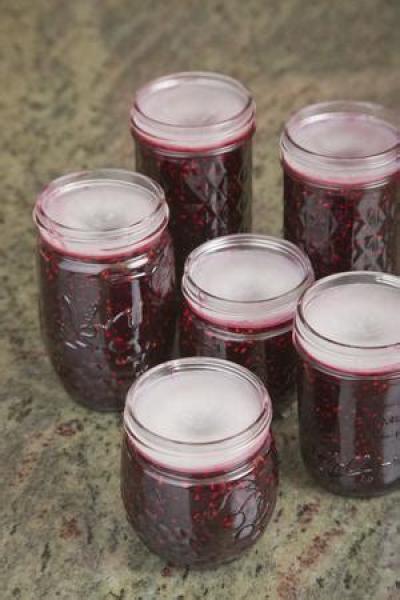
This is how jelly was made between 1900 and 1910 in England.
All fruits for Jelly making should be gathered just before they are fully ripe and on a dry day. Acid fruits are most suitable as they contain more pectin – the jellying principle - than the sweeter varieties. Strawberries and blackberries are difficult to make jelly from without the addition of some other type of fruit, such as apple, currants, etc.
Currant and Grape Jellies.
Pick over the fruit carefully and remove all foreign matter; put in a preserving kettle and crush to liberate the juice, heat till it flows freely, then place in a jelly bag previously wrung out of cold water, and let the juice drip slowly. It may be left to drip over night. Measure, heat to boiling point, add the heated sugar - pound to pint - and boil five minutes; skim if necessary, test and, if it jellies, pour at once into glasses. Cover according to any of the directions given later.
If a light, delicate color is desired in making currant jelly, the stalks must be removed. This takes time, but the result warrants it. In some cases good jelly can be made by using only three-fourths of a pint of sugar to a pint of juice. This applies to fruits which contain a large proportion of sugar in themselves and also when the season is exceptionally dry and sunny.
Apple, Plum, Crab-Apple or Quince Jelly.
Wash, wipe and stem, and from apples, crab-apples and quinces remove the blossom; quinces need hard rubbing to remove the fuzz; from plums remove the stones. Cut all fruits into convenient-sized pieces, using a silver knife to prevent discoloration, and add water - for apples and crab-apples have as much water as fruit; for the other kinds of fruit use a little less water as they have more juices of their own. Cook until tender and strain through a jelly bag. Measure the juice and add the sugar, pound to pint, unless the fruit is very sweet, when a little less should be used; cook till the juice jellies when a little is cooled in a saucer; then put into glasses, and cover. It must be remembered that too long boiling destroys the jellying principle; consequently the fruit must not be allowed to cook longer than necessary.
If the sugar is heated after measuring, the jelly will be clearer and jell more quickly. The heating can be done while the fruit is coming to the boiling point.
Jellies made by the Cold Process are the most delicate, but as not likely to keep quite as well as when fruit juice and sugar are cooked together. The method followed is the same as for ordinary jelly so far as the cooking, straining and measuring of the fruit and juice are concerned. The sugar - pound for pint - is added to the strained juice and dissolved; the sterilized glasses filled, and covered with sheets of glass to keep out the dust and attract the rays of the sun, and the jellies left in a sunny place till set. They are then covered according to the directions given.
To Cover Jellies
There are three methods in common use:
-
Dip a round of paper in either alcohol or brandy, lay it on top of the jelly as soon as it is cold and then put the tin cover of the glass over the top.
-
Dip a round of paper in slightly-beaten white of egg, cover the glass with this and press down till the paper adheres closely. The paper must be large enough to overlap the top of the glass as least half in inch on all sides.
-
Cover the jelly, when cold, with melted paraffin wax, having the wax quarter of an inch thick as it contracts when cold, and if too thin a portion of the jelly will be left uncovered.
Published U.S. Legacies 2002
- Log in to post comments
